Manage Exponential Value Relationships

Implementing exponential IT will require businesses to work with external vendors to facilitate the rapid adoption of cutting-edge technologies such as generative artificial intelligence. IT leaders must:
These challenges require new skills which build trust and collaboration among vendors.
Our Advice
Critical Insight
Outcome-based relationships require a higher degree of trust than traditional vendor relationships. Build trust by sharing risks and rewards.
Impact and Result
- Assess your readiness to take on the new types of vendor relationships that will help you succeed.
- Identify where you need to build your capabilities in order to successfully manage relationships.
- Successfully manage outcomes, financials, risk, and relationships in complex vendor relationships.
Manage Exponential Value Relationships Research & Tools
Besides the small introduction, subscribers and consulting clients within this management domain have access to:
1. Manage Exponential Value Relationships Storyboard – Learn about the new era of exponential vendor relationships and the capabilities needed to succeed.
This research walks you through how to assess your capabilities to undertake a new model of vendor relationships and drive exponential IT.
- Manage Exponential Value Relationships Storyboard
2. Exponential Relationships Readiness Assessment – Assess your readiness to engage in exponential vendor partnerships.
This tool will facilitate your readiness assessment.
- Exponential Relationships Readiness Assessment
Further reading
Manage Exponential Value Relationships
Are you ready to manage outcome-based agreements?
Analyst Perspective
Outcome-based agreements require a higher degree of mutual trust.

|
Exponential IT brings with it an exciting new world of cutting-edge technology and increasingly accelerated growth of business and IT. But adopting and driving change through this paradigm requires new capabilities to grow impactful and meaningful partnerships with external vendors who can help implement technologies like artificial intelligence and virtual reality. Building outcome-based partnerships involves working very closely with vendors who, in many cases, will have just as much to lose as the organizations implementing these new technologies. This requires a greater degree of trust between parties than a standard vendor relationship. It also drastically increases the risks to both organizations; as each loses some control over data and outcomes, they must trust that the other organization will follow through on commitments and obligations. Outcome-based partnerships build upon traditional vendor management practices and create the potential for organizations to embrace emerging technology in new ways. Kim Osborne Rodriguez |
Executive Summary
|
Exponential IT drives change |
Vendor relationships must evolve |
To deliver exponential value |
|---|---|---|
|
Implementing exponential IT will require businesses to work with external vendors to facilitate the rapid adoption of cutting-edge technologies such as generative artificial intelligence. IT leaders must:
These challenges require new skills which build trust and collaboration with vendors. |
Traditional vendor management approaches are still important for organizations to develop and maintain. But exponential relationships bring new challenges:
IT leaders must adapt traditional vendor management capabilities to successfully lead this change. |
Outcome-based relationships should not be undertaken lightly as they can significantly impact the risk profile of the organization. Use this research to:
Exponential value relationships will help drive exponential IT and autonomization of the enterprise. |
Info-Tech Insight
Outcome-based partnerships require a higher degree of trust than traditional vendor relationships. Build trust by sharing risks and rewards.
Vendor relationships can be worth billions of dollars
Positive vendor relationships directly impact the bottom line, sometimes to the tune of billions of dollars annually.
- Organizations typically spend 40% to 80% of their total budget on external suppliers.
- Greater supplier trust translates directly to greater business profits, even in traditional vendor relationships.1
- Based on over a decade of data from vehicle manufacturers, greater supplier relationships nearly doubled the unit profit margin on vehicles, contributing over $20 billion to Toyota’s annual profits based on typical sales volume.2
- Having positive vendor relationships can be instrumental in times of crisis – when scarcity looms, vendors often choose to support their best customers.3,4 For example, Toyota protected itself from the losses many original equipment manufacturers (OEMs) faced in 2020 and showed improved profitability that year due to increased demand for vehicles which it was able to supply as a result of top-ranked vendor relationships.
1 PR Newswire, 2022.
2 Based on 10 years of data comparing Toyota and Nissan, every 1-point increase in the company’s Working Relations Index was correlated with a $15.77 net profit increase per unit. Impact on Toyota annual profits is based on 10.5 million units sold in 2021 and 2022.
3 Interview with Renee Stanley, University of Texas at Arlington. Conducted 17 May 2023.
4 Plante Moran, 2020.
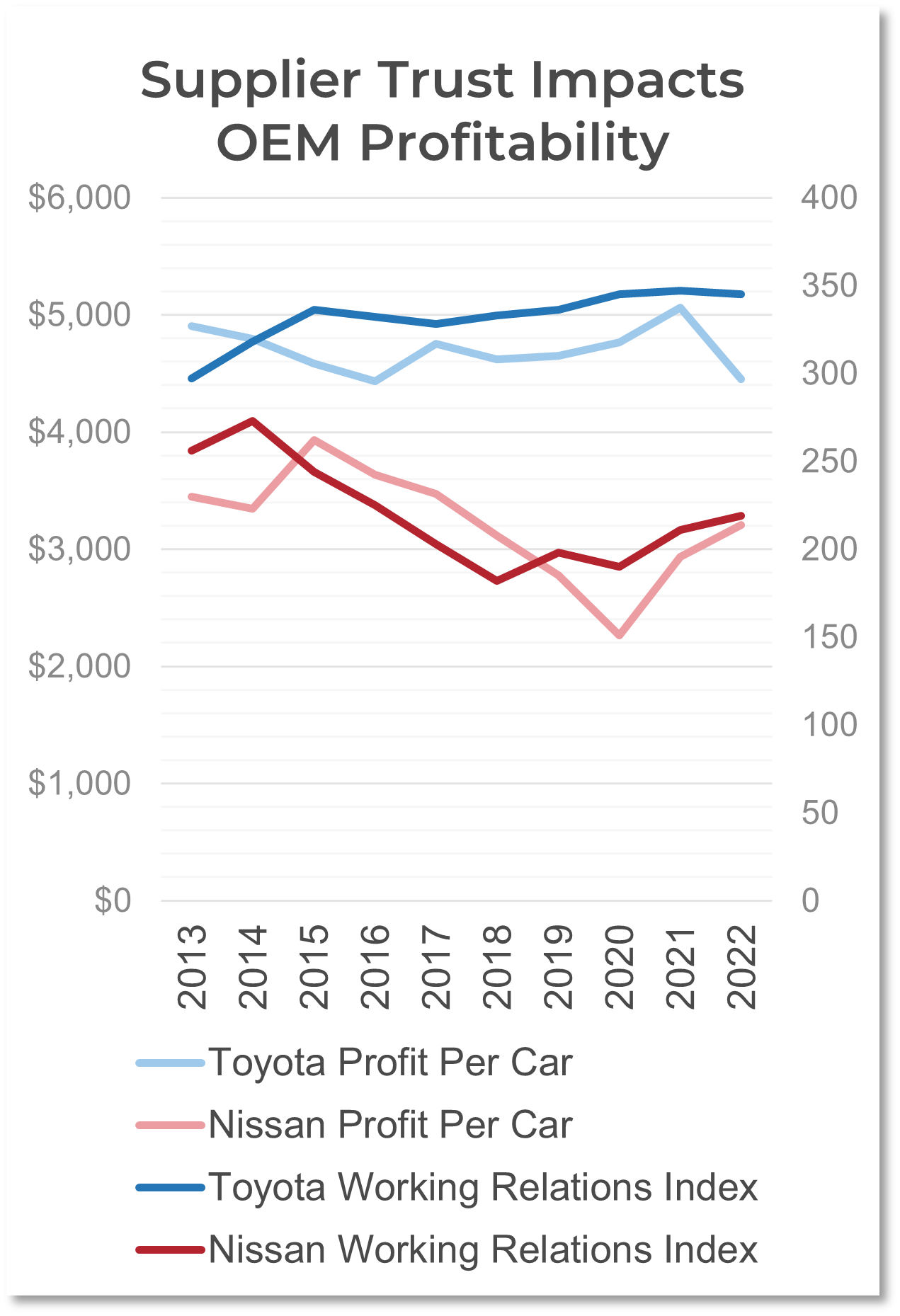
Sources: Macrotrends, Plante Moran 2022, Nissan 2022 and 2023, and Toyota 2022. Profit per car is based on total annual profit divided by total annual sales volume.
Outcome-based relationships are a new paradigm
In a new model where organizations are procuring autonomous capabilities, outcomes will govern vendor relationships.
An outcome-based relationship requires a higher level of mutual trust than traditional vendor relationships. This requires shared reward and shared risk.
Don’t forget about traditional vendor management relationships! Not all vendor relationships can (or should) be outcome-based.
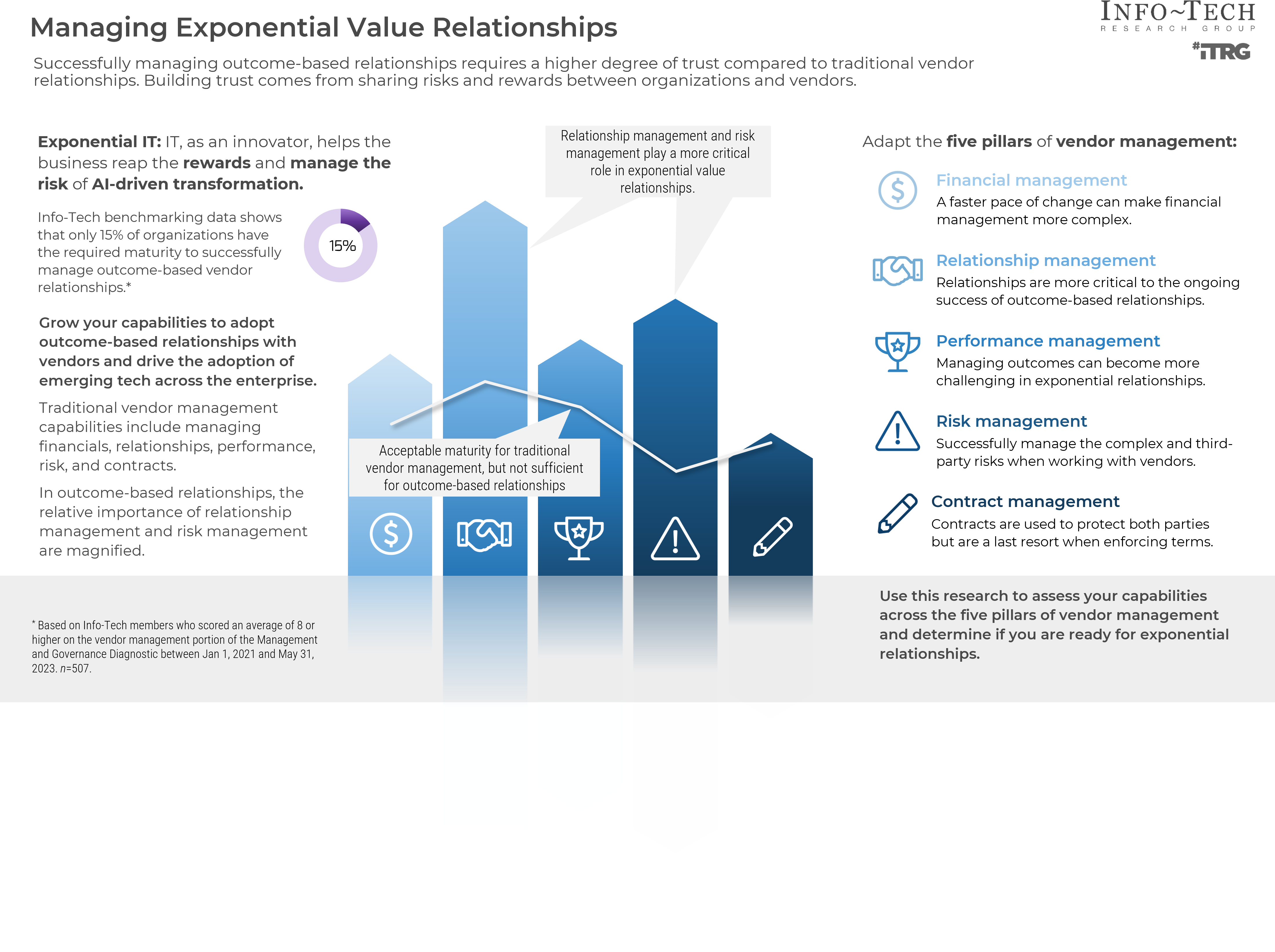
Case study
INDUSTRY: Technology
SOURCE: Press Release
Microsoft and OpenAI partner on Azure, Teams, and Microsoft Office suite
In January 2023, Microsoft announced a $10 billion investment in OpenAI, allowing OpenAI to continue scaling its flagship large language model, ChatGPT, and giving Microsoft first access to deploy OpenAI’s products in services like GitHub, Microsoft Office, and Microsoft Teams.
Shared risk
Issues with OpenAI’s platforms could have a debilitating effect on Microsoft’s own reputation – much like Google’s $100 billion stock loss following a blunder by its AI platform Bard – not to mention the financial loss if the platform does not live up to the hype.
Shared reward
This was a particularly important strategic move by Microsoft, as its main competitors develop their own AI models in a race to the top. This investment also gave OpenAI the resources to continue scaling and evolving its services much faster than it would be capable of on its own. If OpenAI’s products succeed, there is a significant upside for both companies.
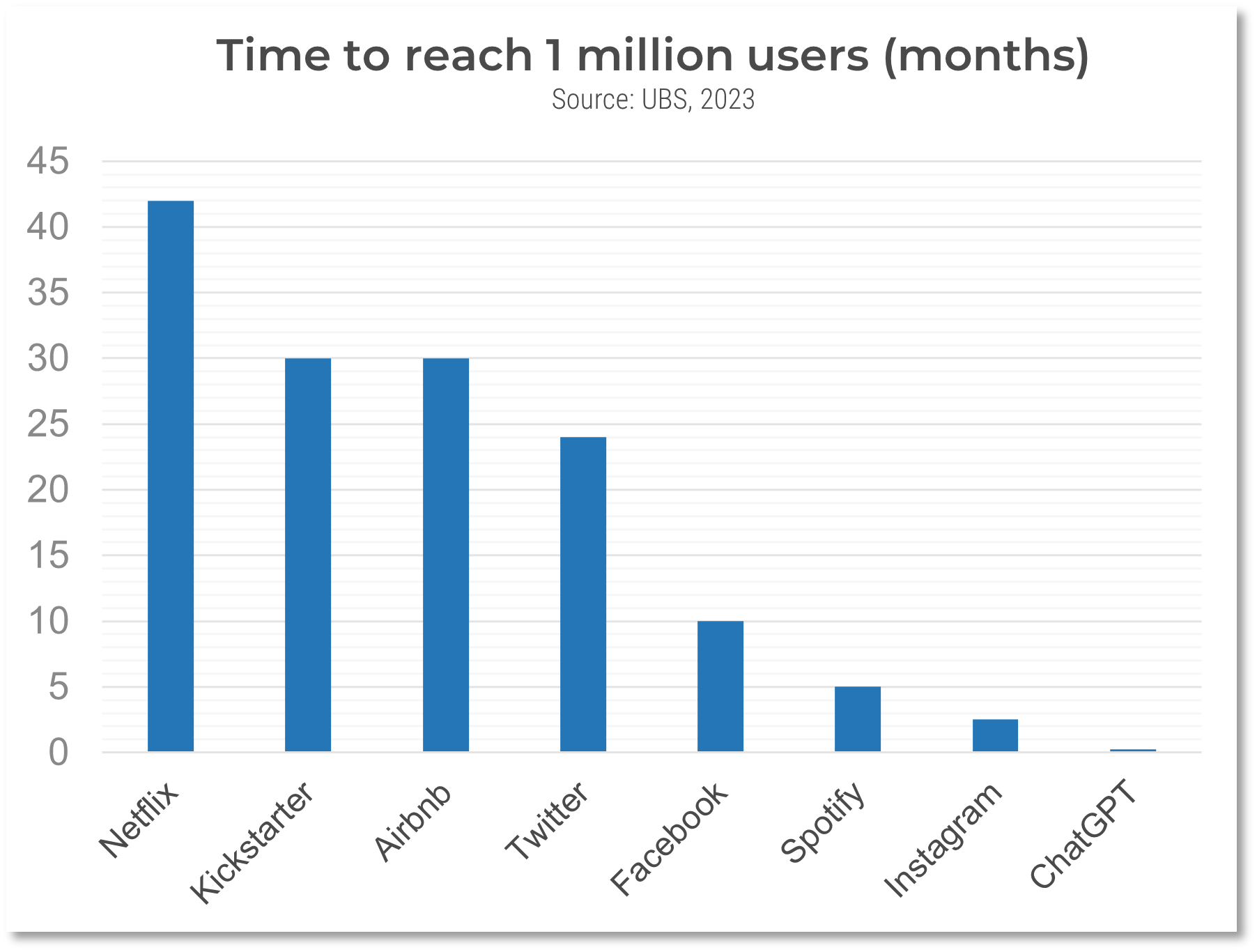
Adapt your approach to vendor relationships
Both traditional vendors and exponential relationships are important.
|
Traditional procurement |
Vendor management |
Exponential vendor relationships |
|---|---|---|
|
|
Use this research to successfully |
Use Info-Tech’s research to Jump Start Your Vendor Management Initiative.
Common obstacles
Exponential relationships require new approaches to vendor management as businesses autonomize:
- Autonomization refers to the shift toward autonomous business capabilities which leverage technologies such as AI and quantum computing to operate independently of human interaction.
- The speed and complexity of technology advancement requires that businesses move quickly and confidently to develop strong relationships and deliver value.
- We are seeing businesses shift from procuring products and services to procuring autonomous business capabilities (sometimes called “as a service,” or aaS). This shift can drive exponential value but also increases complexity and risk.
- Exponential IT requires a shift in emphasis toward more mature relationship and risk management strategies, compared to traditional vendor management.
The shift from technology service agreements to business capability agreements needs a new approach
Eighty-seven percent of organizations are currently experiencing talent shortages or expect to within a few years.
Source: McKinsey, “Mind the [skills] gap”, 2021.
Sixty-three percent of IT leaders plan to implement AI in their organizations by the end of 2023.
Source: Info-Tech Research Group survey, 2022
Insight summary
|
Build trust |
Successfully managing exponential relationships requires increased trust and the ability to share both risks and rewards. Outcome-based vendors typically have greater access to intellectual property, customer data, and proprietary methods, which can pose a risk to the organization if this information is used to benefit competitors. Build mutual trust by sharing both risks and rewards. |
|---|---|
|
Manage risk |
Outcome-based relationships with external vendors can drastically affect an organization’s risk profile. Carefully consider third-party risk and shared risk, including ESG risk, as well as the business risk of losing control over capabilities and assets. Qualified risk specialists (such as legal, regulatory, contract, intellectual property law) should be consulted before entering outcome-based relationships. |
|
Drive outcomes |
Fostering strategic relationships can be instrumental in times of crisis, when being the customer of choice for key vendors can push your organization up the line from the vendor’s side – but be careful about relying on this too much. Vendor objectives may not align with yours, and in the end, everyone needs to protect themselves. |
Assess your readiness for exponential value relationships
Key deliverable:
Exponential Relationships Readiness Assessment
Determine your readiness to build exponential value relationships.
Measure the value of this blueprint
Save thousands of dollars by leveraging this research to assess your readiness, before you lose millions from a relationship gone bad.
Our research indicates that most organizations would take months to prepare this type of assessment without using our research. That’s over 80 person-hours spent researching and gathering data to support due diligence, for a total cost of thousands of dollars. Doesn’t your staff have better things to do?
Start by answering a few brief questions, then return to this slide at the end to see how much your answers have changed.
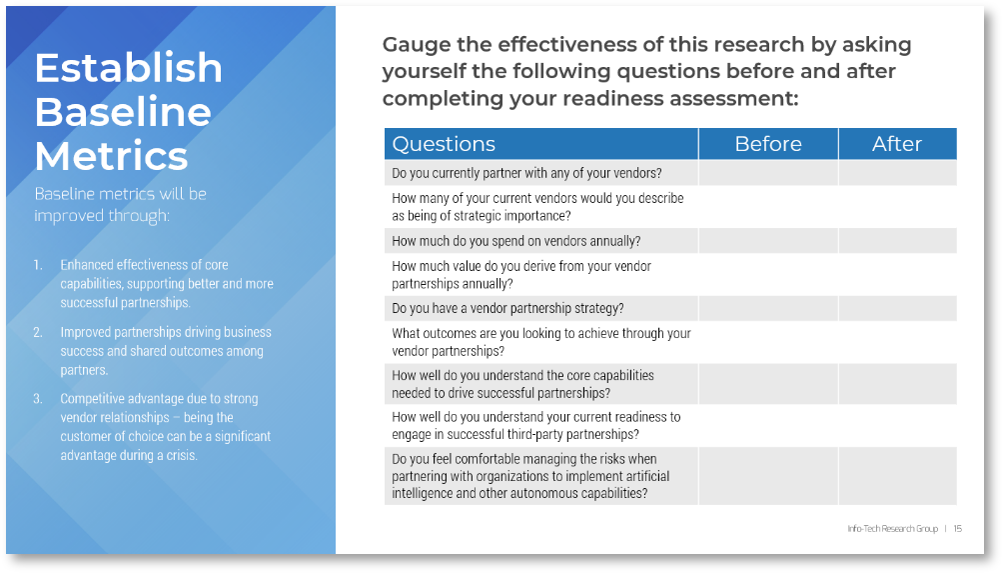
Use Info-Tech’s research to Exponential Relationships Readiness Assessment.
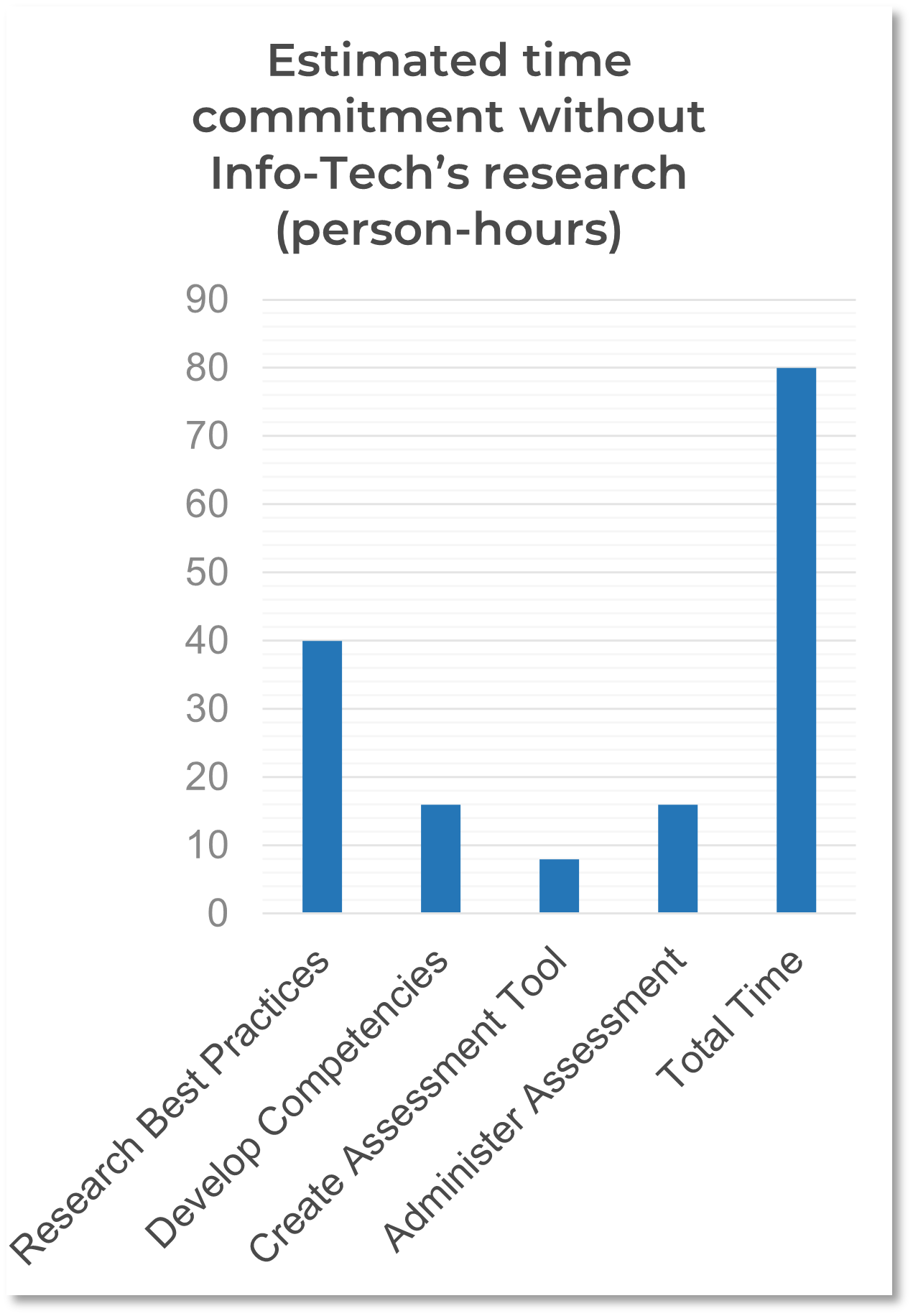
Establish a baseline
Gauge the effectiveness of this research by asking yourself the following questions before and after completing your readiness assessment:
|
Questions |
Before |
After |
|---|---|---|
|
To what extent are you satisfied with your current vendor management approach? |
||
|
How many of your current vendors would you describe as being of strategic importance? |
||
|
How much do you spend on vendors annually? |
||
|
How much value do you derive from your vendor relationships annually? |
||
|
Do you have a vendor management strategy? |
||
|
What outcomes are you looking to achieve through your vendor relationships? |
||
|
How well do you understand the core capabilities needed to drive successful vendor management? |
||
|
How well do you understand your current readiness to engage in outcome-based vendor relationships? |
||
|
Do you feel comfortable managing the risks when working with organizations to implement artificial intelligence and other autonomous capabilities? |
How to use this research
Five tips to get the most out of your readiness assessment.
- Each category consists of five competencies, with a maximum of five points each. The maximum score on this assessment is 100 points.
- Effectiveness levels range from basic (level 1) to advanced (level 5). Level 1 is generally considered the baseline for most effectively operating organizations. If your organization is struggling with level 1 competencies, it is recommended to improve maturity in those areas before pursuing exponential relationships.
- This assessment is qualitative; complete the assessment to the best of your ability, based on the scoring rubric provided. If you fall between levels, use the lower one in your assessment.
- The scoring rubric may not perfectly fit the processes and practices within every organization. Consider the spirit of the description and score accordingly.
- Other industry- and region-specific competencies may be required to succeed at exponential relationships. The competencies in this assessment are a starting point, and internal validation and assessments should be conducted to uncover additional competencies and skills.
Financial management
Manage your budget and spending to stay on track throughout your relationship.
“Most organizations underestimate the amount of time, money, and skill required to build and maintain a successful relationship with another organization. The investment in exponential relationships is exponential in itself – as are the returns.”
– Jennifer Perrier, Principal Research Director,
Info-Tech Research Group
This step involves the following participants:
- Executive leadership team, including CIO
- CFO
- Vendor management leader
- Other internal stakeholders of vendor relationships
Activities:
- Assess your ability to manage scope and budget in exponential IT relationships.
Successfully manage complex finances
Stay on track and keep your relationship running smoothly.
Why is this important?
- Finance is at the core of most business – it drives decision making, acts as a constraint for innovation and optimization, and plays a key role in assessing options (such as return on investment or payback period).
- Effectively managing finances is a critical success factor in developing strong relationships. Each organization must be able to manage their own budget and spending in order to balance the risk and reward in the relationship. Often, these risks and rewards will come in the form of profit and loss or revenue and spend.
Build it into your practice:
- Ensure your financial decision-making practices are aligned with the organizational and relationship strategy. Do metrics and criteria reflect the organization’s goals?
- Develop strong accounting and financial analysis practices – this includes the ability to conduct financial due diligence on potential vendors.
- Develop consistent methodology to track and report on the desired outcomes on a regular basis.
Build your ability to manage finances
The five competencies needed to manage finances in exponential value relationships are:
|
Budget procedures |
Financial alignment |
Adaptability |
Financial analysis |
Reporting & compliance |
|---|---|---|---|---|
|
Clearly articulate and communicate budgets, with proactive analysis and reporting. |
There is a strong, direct alignment between financial outcomes and organizational strategy and goals. |
Financial structures can manage many different types of relationships and structures without major overhaul. |
Proactive financial analysis is conducted regularly, with actionable insights. |
This exceeds legal requirements and includes proactive and actionable reporting. |
Relationship management
Drive exponential value by becoming a customer of choice.
“The more complex the business environment becomes — for instance, as new technologies emerge or as innovation cycles get faster — the more such relationships make sense. And the better companies get at managing individual relationships, the more likely it is that they will become “partners of choice” and be able to build entire portfolios of practical and value-creating partnerships.”
(“Improving the management of complex business partnerships.” McKinsey, 2019)
This step involves the following participants:
- Executive leadership team, including CIO
- Vendor management leader
- Other internal stakeholders of vendor relationships
Activities:
- Assess your ability to manage relationships in exponential IT relationships.
Take your relationships to the next level
Maintaining positive relationships is key to building trust.
Why is this important?
- All relationships will experience challenges, and the ability to resolve these issues will rely heavily on the relationship management skills and soft skills of the leadership within each organization.
- Based on a 20-year study of vendor relationships in the automotive sector, business-to-business trust is a function of reasonable demands, follow-through, and information sharing.
(Source: Plante Moran, 2020)
Build it into your practice:
- Develop the soft skills necessary to promote psychological safety, growth mindset, and strong and open communication channels.
- Be smart about sharing information – you don’t need to share everything, but being open about relevant information will enhance trust.
- Both parties need to work hard to develop trust necessary to build a true relationship. This will require increased access to decision-makers, clearly defined guardrails, and the ability for unsatisfied parties to leave.
Build your ability to manage relationships
The five competencies needed to manage relationships in exponential partnerships are:
|
Strategic alignment |
Follow-through |
Information sharing |
Shared risk & rewards |
Communication |
|---|---|---|---|---|
|
Work with vendors to create roadmaps and strategies to drive mutual success. |
Ensure demands are reasonable and consistently follow through on commitments. |
Proactively and freely share relevant information between parties. |
Equitably share responsibility for outcomes and benefits from success. |
Ensure clear, proactive, and frequent communication occurs between parties. |
Performance management
Outcomes management focuses on results, not methods.
According to Jennifer Robinson, senior editor at Gallup, “This approach focuses people and teams on a concrete result, not the process required to achieve it. Leaders define outcomes and, along with managers, set parameters and guidelines. Employees, then, have a high degree of autonomy to use their own unique talents to reach goals their own way.” (Forbes, 2023)
In the context of exponential relationships, vendors can be given a high degree of autonomy provided they meet their objectives.
This step involves the following participants:
- Executive leadership team, including CIO
- Vendor management leader
- Other internal stakeholders of vendor relationships
Activities:
- Assess your ability to manage outcomes in exponential IT relationships.
Manage outcomes to drive mutual success
Build trust by achieving shared objectives.
Why is this important?
- Relationships are based on shared risk and shared reward for all parties. In order to effectively communicate the shared rewards, you must first understand and communicate your objectives for the relationship, then measure outcomes to ensure all parties are benefiting.
- Effectively managing outcomes reduces the risk that one party will choose to leave based on a perception of benefits not being achieved. Parties may still leave the agreement, but decisions should be based on shared facts and issues should be communicated and addressed early.
Build it into your practice:
- Clearly articulate what you hope to achieve by entering an outcome-based relationship. Each party should outline and agree to the goals, objectives, and desired outcomes from the relationship.
- Document how rewards will be shared among parties. What type of rewards are anticipated? Who will benefit and how?
- Develop consistent methodology to track and report on the desired outcomes on a regular basis. This might consist of a vendor scorecard or a monthly meeting.
Build your ability to manage outcomes
The five competencies needed to manage outcomes in exponential value relationships are:
|
Goal setting |
Negotiation |
Performance tracking |
Issue |
Scope management |
|---|---|---|---|---|
|
Set specific, measurable and actionable goals, and communicate them with stakeholders. |
Clearly articulate and agree upon measurable outcomes between all parties. |
Proactively track progress toward goals/outcomes and discuss results with vendors regularly. |
Openly discuss potential issues and challenges on a regular basis. Find collaborative solutions to problems. |
Proactively manage scope and discuss with vendors on a regular basis. |
Risk management
Exponential IT means exponential risk – and exponential rewards.
One of the key differentiators between traditional vendor relationships and exponential relationships is the degree to which risk is shared between parties. This is not possible in all industries, which may limit companies’ ability to participate in this type of exponential relationship.
This step involves the following participants:
- Executive leadership team, including CIO
- Vendor management leader
- Risk management leader
- Other internal stakeholders of vendor relationships
Activities:
- Assess your ability to manage risk in exponential IT relationships.
Relationships come with a lot of hidden risks
Successfully managing complex risks can be the difference between a spectacular success and company-ending failure.
Why is this important?
- Relationships inherently involve a loss of control. You are relying on another party to fulfill their part of the agreement, and you depend on the success of the outcome. Loss of control comes with significant risks.
- Sharing in risk is what differentiates an outcome-based relationship from a traditional vendor relationship; vendors must have skin in the game.
- Organizations must consider many different types of risk when considering a relationship with a vendor: fraud, security, human rights, labor relations, ESG, and operational risks. Remember that risk is not inherently bad; some risk is necessary.
Build it into your practice:
- Build or hire the necessary risk expertise needed to properly assess and evaluate the risks of potential vendor relationships. This includes intellectual property, ESG, legal/regulatory, cybersecurity, data security, and more.
- Develop processes and procedures which clearly communicate and report on risk on a regular basis.
Info-Tech Insight
Some highly regulated industries (such as finance) are prevented from transferring certain types of risk. In these industries, it may be much more difficult to form vendor relationships.
Don’t forget about third-party ESG risk
Customers care about ESG. You should too.
Protect yourself against third-party ESG risks by considering the environmental and social impacts of your vendors.
Third-party ESG risks can include the following:
- Environmental risk: Vendors with unsustainable practices such as carbon emissions or waste generation of natural resource depletion can negatively impact the organization’s environmental goals.
- Social risk: Unsafe or illegal labor practices, human rights violations, and supply chain management issues can reflect negatively on organizations that choose to work with vendors who engage in such practices.
- Governance risk: Vendors who engage in illegal or unethical behaviors, including bribery and corruption or data and privacy breaches can impact downstream customers.
Working with vendors that have a poor record of ESG carries a very real reputational risk for organizations who do not undertake appropriate due diligence.
A global survey of nearly 14,000 customers revealed that…
Source: EY Future Consumer Index, 2021
Seventy-seven percent of customers believe companies have a responsibility to manufacture sustainably.
Sixty-eight percent of customers believe businesses should ensure their suppliers meet high social and environmental standards.
Fifty-five percent of customers consider the environmental impact of production in their purchasing decisions.
Build your ability to manage risk
The five competencies needed to manage risk in exponential value relationships are:
|
Third-party risk |
Value chain |
Data management |
Regulatory & compliance |
Monitoring & reporting |
|---|---|---|---|---|
|
Understand and assess third-party risk, including ESG risk, in potential relationships. |
Assess risk throughout the value chain for all parties and balance risk among parties. |
Proactively assess and manage potential data risks, including intellectual property and strategic data. |
Manage regulatory and compliance risks, including understanding risk transfer and ultimate risk holder. |
Proactive and open monitoring and reporting of risks, including regular communication among stakeholders. |
Contract management
Contract management is a critical part of vendor management.
Well-managed contracts include clearly defined pricing, performance-based outcomes, clear roles and responsibilities, and appropriate remedies for failure to meet requirements. In outcome-based relationships, contracts are generally used as a secondary method of enforcing performance, with relationship management being the primary method of addressing challenges and ensuring performance.
This step involves the following participants:
- Executive leadership team, including CIO
- Vendor management leader
- Risk management leader
- Other internal stakeholders of vendor relationships
Activities:
- Assess your ability to manage risk in exponential IT relationships.
Build your ability to manage contracts
The five competencies needed to manage contracts in exponential value relationships are:
|
Pricing |
Performance outcomes |
Roles and responsibilities |
Remedies |
Payment |
|---|---|---|---|---|
|
Pricing is clearly defined in contracts so that the total cost is understood including all fees, optional pricing, and set caps on increases. |
Contracts are performance-based whenever possible, including deliverables, milestones, service levels, due dates, and outcomes. |
Each party's roles and responsibilities are clearly defined in the contract documents with adequate detail. |
Contracts contain appropriate remedies for a vendor's failure to meet SLAs, due dates, and other obligations. |
Payment is made after performance targets are met, approved, or accepted. |
Activity 1: Assess your readiness for exponential relationships
1-3 hours
- Gather key stakeholders from across your organization to participate in the readiness assessment exercise.
- As a group, review the core competencies from the previous four sections and determine where your organization’s effectiveness lies for each competency. Record your responses in the Exponential Relationships Readiness Assessment tool.
Download the Exponential Relationships Readiness Assessment tool.
| Input | Output |
|---|---|
|
|
| Materials | Participants |
|
|
Understand your assessment
This step involves the following participants:
- Executive leadership team, including CIO
- Vendor management leader
- Other internal stakeholders of vendor relationships
Activities:
- Create an action plan.
Understand the results of your assessment
Consider the following recommendations based on your readiness assessment scores:
- The chart to the right shows sample results. The bars indicate the recommended scores, and the line indicates the readiness score.
- Three or more categories below the recommended scores, or any categories more than five points below the recommendation: outcome-based relationships are not recommended at this time.
- Two or more categories below the recommended scores: Proceed with caution and limit outcome-based relationships to low-risk areas. Continue to mature capabilities.
- One category below the recommended scores: Evaluate the risks and benefits before engaging in higher-risk vendor relationships. Continue to mature capabilities.
- All categories at or above the recommended scores: You have many of the core capabilities needed to succeed at exponential relationships! Continue to evaluate and refine your vendor relationships strategy, and identify any additional competencies needed based on your industry or region.
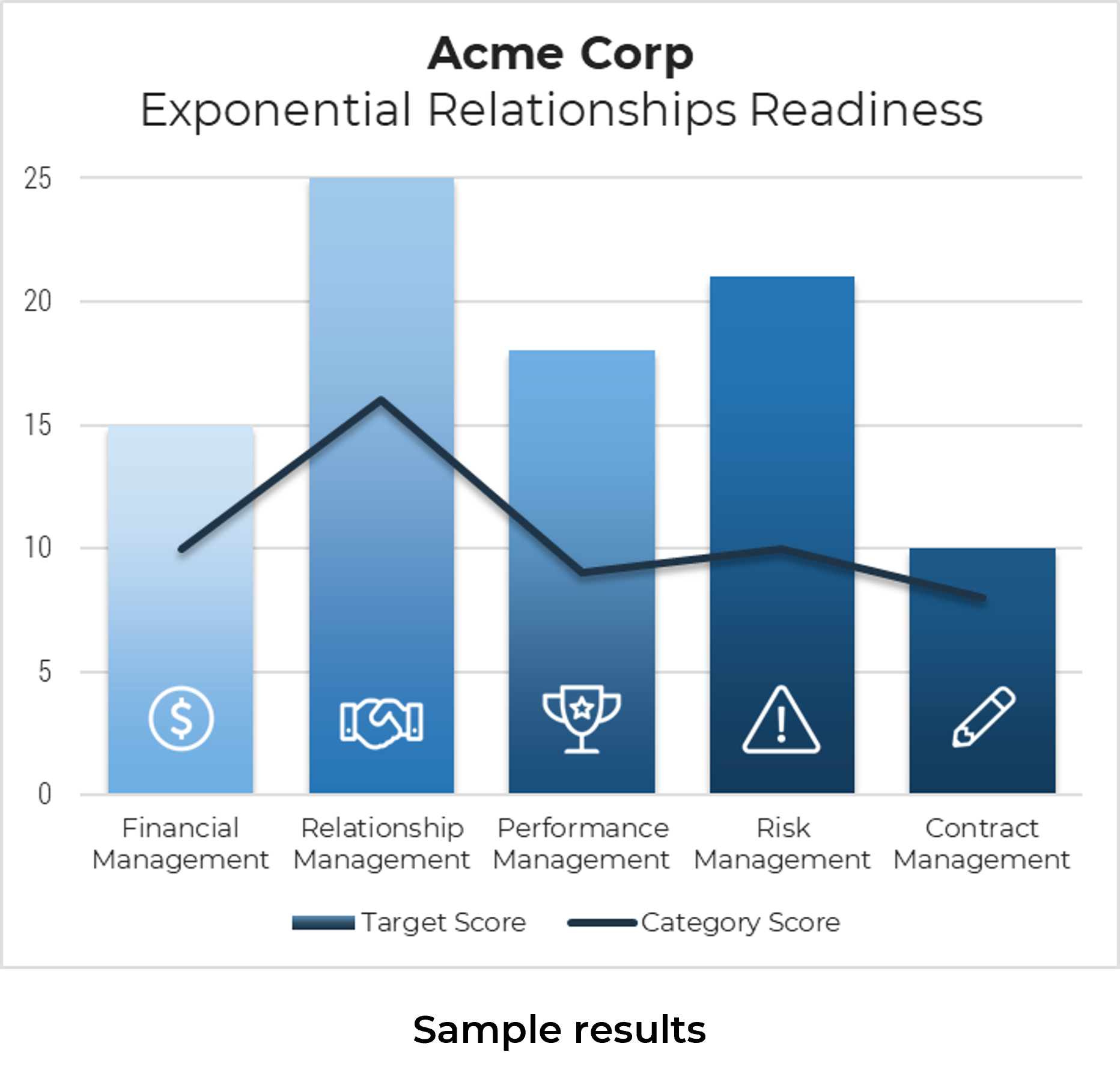
Activity 2: Create an action plan
1 hour
- Gather the stakeholders who participated in the readiness assessment exercise.
- As a group, review the results of the readiness assessment. Where there any surprise? Do the results reflect your understanding of the organization’s maturity?
- Determine which areas are likely to limit the organization’s relationship capability, based on lowest scoring areas and relative importance to the organization.
- Break out into groups and have each group identify three actions the organization could take to mature the lowest scoring areas.
- Bring the group back together and prioritize the actions. Note who will be accountable for each next step.
| Input | Output |
|---|---|
|
|
| Materials | Participants |
|
|
Related Info-Tech Research
Jump Start Your Vendor Management Initiative
Create and implement a vendor management framework to begin obtaining measurable results in 90 days.
Elevate Your Vendor Management Initiative
Transform your VMI from tactical to strategic to maximize its impact and value
Evaluate Your Vendor Account Team to Optimize Vendor Relations
Understand the value of knowing your account team’s influence in the organization, and your influence, to drive results.
Related Info-Tech Research
Build an IT Risk Management Program
Mitigate the IT risks that could negatively impact your organization.
Build an IT Budget
Effective IT budgets are more than a spreadsheet. They tell a story.
Adopt an Exponential IT Mindset
Thrive through the next paradigm shift..
Author

|
Kim Osborne Rodriguez |
|
Kim is a professional engineer and Registered Communications Distribution Designer (RCDD) with over a decade of experience in management and engineering consulting spanning healthcare, higher education, and commercial sectors. She has worked on some of the largest hospital construction projects in Canada, from early visioning and IT strategy through to design, specifications, and construction administration. She brings a practical and evidence-based approach, with a track record of supporting successful projects. Kim holds a Bachelor’s degree in Honours Mechatronics Engineering and an option in Management Sciences from the University of Waterloo. |
Research Contributors and Experts

|
Jack Hakimian Jack has more than 25 years of technology and management consulting experience. He has served multibillion-dollar organizations in multiple industries including financial services and telecommunications. Jack also served several large public sector institutions. He is a frequent speaker and panelist at technology and innovation conferences and events and holds a Master’s degree in Computer Engineering as well as an MBA from the ESCP-EAP European School of Management. |

|
Michael Tweedie Mike Tweedie brings over 25 years as a technology executive. He’s led several large transformation projects across core infrastructure, application and IT services as the head of Technology at ADP Canada. He was also the Head of Engineering and Service Offerings for a large French IT services firm, focused on cloud adoption and complex ERP deployment and management. Mike holds a Bachelor’s degree in Architecture from Ryerson University. |

|
Scott Bickley Scott Bickley is a Practice Lead & Principal Research Director at Info-Tech Research Group, focused on Vendor Management and Contract Review. He also has experience in the areas of IT Asset Management (ITAM), Software Asset Management (SAM), and technology procurement along with a deep background in operations, engineering, and quality systems management. Scott holds a B.S. in Justice Studies from Frostburg State University. He also holds active IAITAM certification designations of CSAM and CMAM and is a Certified Scrum Master (SCM). |

|
Donna Bales Donna Bales is a Principal Research Director in the CIO Practice at Info-Tech Research Group, specializing in research and advisory services in IT risk, governance, and compliance. She brings over 25 years of experience in strategic consulting and product development and has a history of success in leading complex, multistakeholder industry initiatives. Donna has a bachelor’s degree in economics from the University of Western Ontario. |
Research Contributors and Experts

|
Jennifer Perrier Jennifer has 25 years of experience in the information technology and human resources research space, joining Info-Tech in 1998 as the first research analyst with the company. Over the years, she has served as a research analyst and research manager, as well as in a range of roles leading the development and delivery of offerings across Info-Tech’s product and service portfolio, including workshops and the launch of industry roundtables and benchmarking. She was also Research Lead for McLean & Company, the HR advisory division of Info-Tech, during its start-up years. Jennifer’s research expertise spans the areas of IT strategic planning, governance, policy and process management, people management, leadership, organizational change management, performance benchmarking, and cross-industry IT comparative analysis. She has produced and overseen the development of hundreds of publications across the full breadth of both the IT and HR domains in multiple industries. In 2022, Jennifer joined Info-Tech’s IT Financial Management Practice with a focus on developing financial transparency to foster meaningful dialogue between IT and its stakeholders and drive better technology investment decisions. |

|
Phil Bode Phil has 30+ years of experience with IT procurement-related topics: contract drafting and review, negotiations, RFXs, procurement processes, and vendor management. Phil has been a frequent speaker at conferences, a contributor to magazine articles in CIO Magazine and ComputerWorld, and quoted in many other magazines. He is a co-author of the book The Art of Creating a Quality RFP. Phil has a Bachelor of Science in Business Administration with a double major of Finance and Entrepreneurship and a Bachelor of Science in Business Administration with a major of Accounting, both from the University of Arizona. |
Research Contributors

|
Erin Morgan |

|
Renee Stanley |
Note: Additional contributors did not wish to be identified.
Bibliography
Andrea, Dave. “Plante Moran’s 2022 Working Relations Index® (WRI) Study shows supplier relations can improve amid industry crisis.” Plante Moran, 25 Aug 2022. Accessed 18 May 2023.
Andrea, Dave. “Trust between suppliers and OEMs can better prepare you for the next crisis.” Plante Moran, 9 Sept 2020. Accessed 17 May 2023.
Cleary, Shannon, and Carolan McLarney. “Organizational Benefits of an Effective Vendor Management Strategy.” IUP Journal of Supply Chain Management, Vol. 16, Issue 4, Dec 2019.
De Backer, Ruth, and Eileen Kelly Rinaudo. “Improving the management of complex business partnerships.” McKinsey, 21 March 2019. Accessed 9 May 2023 .
Dennean, Kevin et al. “Let's chat about ChatGPT.” UBS, 22 Feb 2023. Accessed 26 May 2023.
F&I Tools. “Nissan Worldwide Vehicle Sales Report.” Factory Warranty List, 2022. Accessed 18 May 2023.
Gomez, Robin. “Adopting ChatGPT and Generative AI in Retail Customer Service.” Radial, 235, April 2023. Accessed 10 May 2023.
Harms, Thomas and Kristina Rogers. “How collaboration can drive value for you, your partners and the planet.” EY, 26 Oct 2021. Accessed 10 May 2023.
Hedge & Co. “Toyota, Honda finish 1-2; General Motors finishes at 3rd in annual Supplier Working Relations Study.” PR Newswire, 23 May 2022. Accessed 17 May 2023.
Henke Jr, John W., and T. Thomas. "Lost supplier trust, lost profits." Supply Chain Management Review, May 2014. Accessed 17 May 2023.
Information Services Group, Inc. “Global Demand for IT and Business Services Continues Upward Surge in Q2, ISG Index™ Finds.” BusinessWire, 7 July 2021. Accessed 8 May 2023.
Kasanoff, Bruce. “New Study Reveals Costs Of Bad Supplier Relationships.” Forbes, 6 Aug 2014. Accessed 17 May 2023.
Macrotrends. “Nissan Motor Gross Profit 2010-2022.” Macrotrends. Accessed 18 May 2023.
Macrotrends. “Toyota Gross Profit 2010-2022.” Macrotrends. Accessed 18 May 2023.
McKinsey. “Mind the [skills] gap.” McKinsey, 27 Jan 2021. Accessed 18 May 2023.
Morgan, Blake. “7 Examples of How Digital Transformation Impacted Business Performance.” Forbes, 21 Jul 2019. Accessed 10 May 2023.
Nissan Motor Corporation. “Nissan reports strong financial results for fiscal year 2022.” Nissan Global Newsroom, 11 May 2023. Accessed 18 May 2023.
Bibliography
“OpenAI and Microsoft extend partnership.” Open AI, 23 Jan 2023. Accessed 26 May 2023.
Pearson, Bryan. “The Apple Of Its Aisles: How Best Buy Lured One Of The Biggest Brands.“ Forbes, 23 Apr 2015. Accessed 23 May 2023.
Perifanis, Nikolaos-Alexandros and Fotis Kitsios. “Investigating the Influence of Artificial Intelligence on Business Value in the Digital Era of Strategy: A Literature Review.” Information, 2 Feb 2023. Accessed 10 May 2023.
Scott, Tim and Nathan Spitse. “Third-party risk is becoming a first priority challenge.” Deloitte. Accessed 18 May 2023.
Stanley, Renee. Interview by Kim Osborne Rodriguez, 17 May 2023.
Statista. “Toyota's retail vehicle sales from 2017 to 2021.” Statista, 27 Jul 2022. Accessed 18 May 2023.
Tlili, Ahmed, et al. “What if the devil is my guardian angel: ChatGPT as a case study of using chatbots in education.” Smart Learning Environments, 22 Feb 2023. Accessed 9 May 2023.
Vitasek, Kate. “Outcome-Based Management: What It Is, Why It Matters And How To Make It Happen.” Forbes, 12 Jan 2023. Accessed 9 May 2023.
Buying Options
Manage Exponential Value Relationships
IT Risk Management · IT Leadership & Strategy implementation · Operational Management · Service Delivery · Organizational Management · Process Improvements · ITIL, CORM, Agile · Cost Control · Business Process Analysis · Technology Development · Project Implementation · International Coordination · In & Outsourcing · Customer Care · Multilingual: Dutch, English, French, German, Japanese · Entrepreneur
Tymans Group is a brand by Gert Taeymans BV
Gert Taeymans bv
Europe: Koning Albertstraat 136, 2070 Burcht, Belgium — VAT No: BE0685.974.694 — phone: +32 (0) 468.142.754
USA: 4023 KENNETT PIKE, SUITE 751, GREENVILLE, DE 19807 — Phone: 1-917-473-8669
Copyright 2017-2022 Gert Taeymans BV